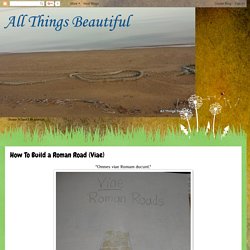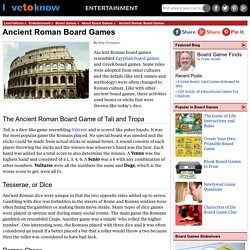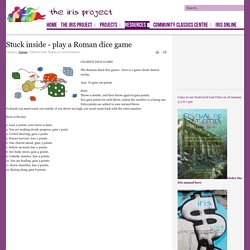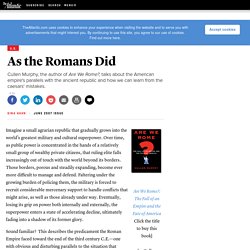

ORBIS: The Stanford Geospatial Network Model of the Roman World. Rome - Online Course. Virginia Certamen Questions. ORBIS: The Stanford Geospatial Network Model of the Roman World. Ginnylindzey.com. Atlas - Browse Curriculum. Suetonius' Twelve Caesars. The Text on LacusCurtius The Latin text is that of Maximilian Ihm in the Teubner edition of 1907, with cosmetic changes as printed in the Loeb Classical Library edition, 1913‑1914.

The English translation is by J. C. Rolfe, printed in the same edition. Both text and translation are in the public domain. As usual, I retyped the text rather than scanning it: not only to minimize errors prior to proofreading, but as an opportunity for me to become intimately familiar with the work, an exercise which I heartily recommend. In the table of contents below, all the Books are shown on blue backgrounds; red backgrounds would indicate that my transcription was still not proofread. And here's an opportunity for me to thank Sergei Gerasenko and John Boal for doing some careful proofreading after me, especially of the Latin text, and catching all kinds of mistakes.
Cave-cerberum - latin in fashion. How To Build a Roman Road (Viae) "Omnes viae Romam ducunt.

" It is true that the Romans were known for their road construction. Here is a fun and tasty way to learn about this. You will need: a 9 x 13 inch dish that you have greased with butter or Pam1 2/3 cup Graham cracker crumbs mixed with 1/4 cup sugar and 1/3 cup melted butter1 large package chocolate pudding, cooled and 1/2 package of chocolate chips stirred in1 tub of whipped cream cheese with 1/3 cup sugar and 1 teaspoon vanilla stirred ina bowl of whipped cream (we used whipping cream whipped with 1/3 cup powdered sugar and a squeeze of lemon juice but Reddi-whip whipped cream would work fine.)Social Tea Biscuits or another 1-layer, thin rectangular shaped cookies (homemade sugar would work fine.) The Roman Roads were made with a layer of sand called Pavimentum on the bottom.We laid the graham cracker crust on the bottom of the pan for this.
The next layer of the Roman road was called Statument, which was stone and mortar mixed together. Now you have a Roman road, Web Codes. Beginning Greek, Again and Again. Ancient Roman Board Games. Ancient Roman board games resembled Egyptian board games and Greek board games.

Some rules were adopted from other cultures and the details (like stick names and mythology) were often changed to Roman culture. Like with other ancient board games, these activities used bones or sticks that were thrown like today's dice. The Ancient Roman Board Game of Tali and Tropa Tali is a dice-like game resembling Yahtzee and is scored like poker hands. It was the most popular game the Romans played. Tesserae, or Dice Ancient Roman dice were unique in that the two opposite sides added up to seven. Roman Chess Roman Chess is an ancient Roman board game that is played on boards with the same number of squares going across and up and down, like an 8x8, or 10x10 board.
Twelve Lines Twelve Lines was played on a board with two rows of twelve squares. Lucky Sixes Lucky Sixes is played on a board with two columns and three rows. Mostly Luck, Some Strategy Post a comment. The Iris Project - Stuck inside - play a Roman dice game. Category: Games Published Date Written by Lorna Robinson The Romans liked dice games - here is a game about chariot racing.

BusyTeacher.org Mobile. In school, most of us were instructed to avoid the passive voice whenever possible....

Like it? Tell your friends: Want more tips like this? Descendants of Troy. Login - Powered by Skyward. This home's Roman-style bath house will blow you away. How literate was the average Roman citizen? Did this vary across Rome's rise and fall, and was there really that big of a difference in literacy of the common man after Rome fell? : AskHistorians. As the Romans Did - Gina Hahn.
Imagine a small agrarian republic that gradually grows into the world’s greatest military and cultural superpower.

Over time, as public power is concentrated in the hands of a relatively small group of wealthy private citizens, that ruling elite falls increasingly out of touch with the world beyond its borders. Those borders, porous and steadily expanding, become ever more difficult to manage and defend. Faltering under the growing burden of policing them, the military is forced to recruit considerable mercenary support to handle conflicts that might arise, as well as those already under way. Eventually, losing its grip on power both internally and externally, the superpower enters a state of accelerating decline, ultimately fading into a shadow of its former glory. Sound familiar? Murphy points to six areas where he feels the parallels between the two superpowers are particularly robust and compelling.
I spoke with him recently by phone. —Gina Hahn. Dacula High School Latin.